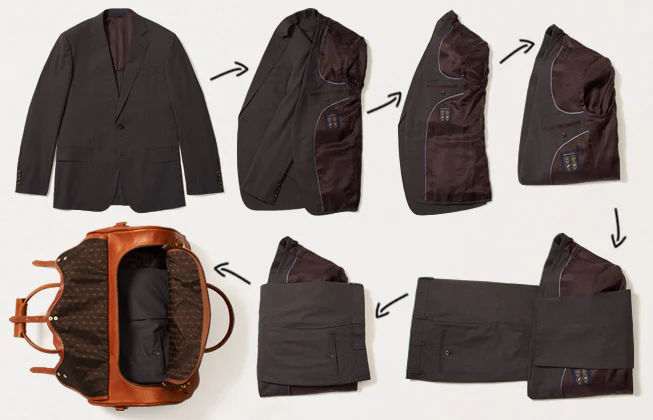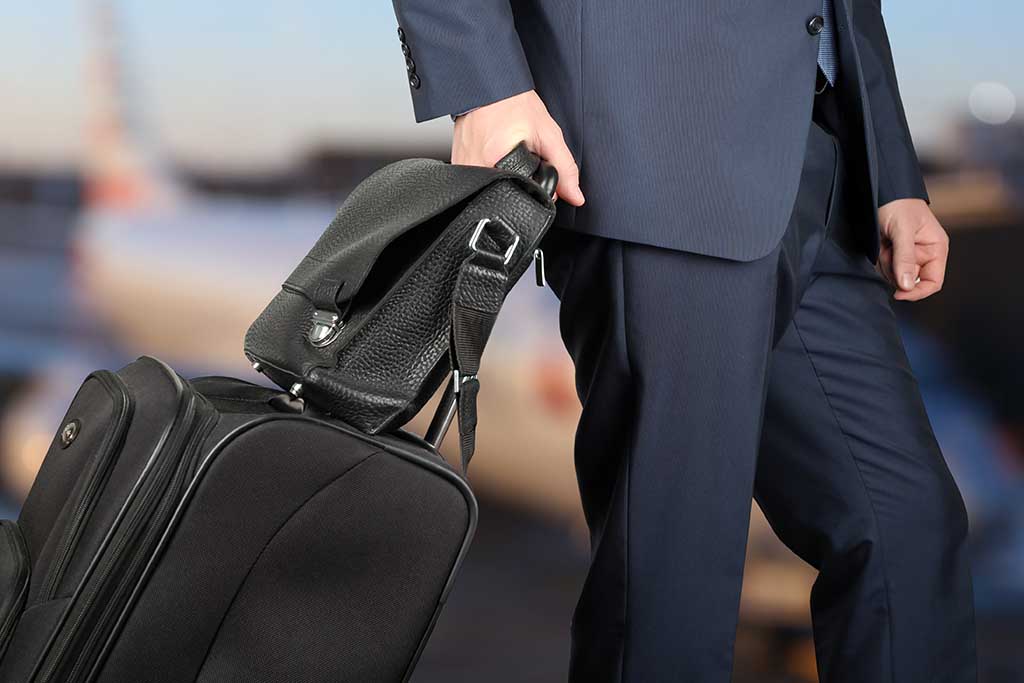How to travel with a suit without it getting wrinkled or damaged is a common concern—especially for business travelers, wedding guests, or anyone attending formal events. The key is in how you prepare, pack, and handle your suit from start to finish.
Before you pack, make sure your suit is freshly cleaned and pressed. A well-prepared suit is far less likely to wrinkle in transit. If possible, use a garment bag, which allows the suit to hang naturally and reduces creases.
Many airlines allow a garment bag as a carry-on item, and some even have onboard closets where you can hang it during the flight.
If you need to pack your suit in a suitcase, use the inside-out jacket fold method. Turn the jacket inside out (to protect the outer fabric), fold it vertically once at the shoulders, and then place it in your suitcase atop soft clothing like shirts.
Fold trousers along the crease line, then roll them gently to reduce wrinkles. You can also place your suit inside a dry-cleaning bag before folding—it reduces friction and keeps fabrics smoother.
Consider packing a portable steamer or wrinkle-release spray. When you arrive at your destination, hang your suit immediately and, if needed, steam out any light wrinkles. Hanging it in the bathroom during a hot shower can also help relax the fabric.
For longer trips, invest in a suit-friendly travel bag or luggage with a built-in garment compartment. Also, pack matching dress shirts, ties, and accessories in separate compartments to stay organized.
In short, traveling with a suit doesn’t have to be stressful. With the right techniques and tools, you can keep your suit looking sharp and professional—no matter where your journey takes you.
Why Traveling with a Suit Requires Extra Care
Traveling with a suit isn’t like packing your everyday clothes—it requires extra attention because suits are delicate, structured garments designed to maintain a sharp, tailored look.
Unlike t-shirts or jeans, suits are made from finer materials like wool, linen, or silk blends, which are more prone to wrinkling, creasing, or even permanent fabric damage if folded incorrectly or compressed for too long.
A well-fitted suit is meant to hold its shape through carefully sewn lines, shoulder padding, and crisp creases in the pants. When carelessly packed in a suitcase or jammed among other clothes, this structure can easily be distorted.
Shoulder pads can flatten, lapels can bend awkwardly, and pants can develop hard-to-remove wrinkles—making your outfit appear sloppy instead of sharp.
Suits are also often worn for important occasions like business meetings, weddings, or formal events where appearance matters. Showing up in a wrinkled or crushed suit not only looks unprofessional but can also leave a poor impression.
That’s why packing your suit properly—whether using a garment bag, carry-on, or wrinkle-minimizing fold—is critical to ensuring you arrive looking polished and put-together.
Additionally, suits may include multiple matching pieces—like jackets, trousers, vests, and accessories—that require thoughtful organization. Losing or damaging one part can render the rest unusable, which is especially frustrating when you’re far from home.
Lastly, certain climates and travel conditions can also affect your suit. Humidity, cramped airline bins, or overstuffed luggage can leave your suit in worse shape than expected if not protected properly.
In short, suits are an investment in your appearance, and taking extra care while traveling helps protect that investment. A little preparation goes a long way in ensuring your suit arrives as crisp and clean as when you packed it.
Fold, Roll, or Carry

When it comes to traveling with a suit, the big question is: should you fold it, roll it, or carry it? The best method depends on your travel style, luggage limitations, and how wrinkle-free you need the suit to be when you arrive.
Carrying your suit in a garment bag is the most effective way to keep it wrinkle-free. Garment bags allow your suit to remain on a hanger, maintaining its shape and avoiding tight folds. Some airlines even have closets for hanging garment bags on long-haul or business-class flights. If you’re traveling for a wedding or high-stakes business meeting, this is your best bet.
Folding a suit, when done correctly, is a practical option if you’re using a carry-on or checked suitcase. The key is to use a method that protects the suit’s structure. For jackets, the inside-out shoulder fold technique works best: turn the jacket inside out and tuck one shoulder into the other to minimize wrinkles. For pants, fold along the crease and lay flat or loosely roll them to reduce pressure lines. Place the folded suit on top of other soft items in your suitcase.
Rolling, though great for t-shirts and casual clothing, is not recommended for suits. Rolling can distort the jacket’s structure, crush shoulder pads, and create deep wrinkles that are hard to remove. However, in rare cases where space is extremely limited, some people use a loose roll combined with a dry-cleaning bag for extra protection.
In summary, carry when you can, fold with care when necessary, and avoid rolling unless you’re in a pinch. The method you choose can make the difference between showing up sharp and confident—or wrinkled and rushed.
Prepping Your Suit Before the Trip
Before you even begin packing, properly prepping your suit is key to keeping it crisp and travel-ready. A well-prepared suit will not only pack better but also hold up far better during transit—reducing the chance of arriving with wrinkles, damage, or a less-than-polished look.
Start by having your suit professionally cleaned and pressed a few days before departure. Freshly cleaned fabric responds better to folding and is less prone to creasing. Be sure to check for loose buttons, fraying threads, or stains, and make repairs if needed. It’s much easier to fix these issues at home than at your destination.
Next, use a proper hanger to maintain the suit’s shape, especially around the shoulders. Even if you’re not traveling with the hanger, letting the suit rest on it for a day after pressing helps relax the fabric and sets the creases neatly.
If you’re folding the suit for packing, place it inside a dry-cleaning bag or plastic garment sleeve. This creates a slippery layer that reduces friction and helps prevent deep creases during travel. For added protection, insert a piece of tissue paper in the sleeves and pants to support folds and cushion the fabric.
Pack your dress shirt, tie, and any accessories separately in a clean, organized way. Consider using a tie case or small pouch to avoid wrinkles and damage. Packing a small wrinkle-release spray or travel steamer is also a smart move for touch-ups on arrival.
Lastly, check the weather at your destination. If you’re heading to a humid or rainy climate, a suit cover or water-resistant garment bag can be a lifesaver.
Proper preparation makes all the difference. With a little care before you pack, your suit will look sharp, stay fresh, and be ready to wear straight out of your luggage.
How to Pack a Suit in a Carry-On
Packing a suit in a carry-on can feel intimidating, but with the right technique, you can arrive wrinkle-free and ready to go—even without a garment bag. The goal is to protect the suit’s structure while minimizing creases, all within limited suitcase space.
Start with the suit jacket. Use the inside-out shoulder fold method, a favorite of frequent business travelers. Turn one shoulder inside out and tuck the other shoulder into it, so the jacket folds in half vertically, with lapels facing outward. This helps preserve the shape of the shoulders and protects the outer fabric. You can then fold the jacket once horizontally or lay it flat, depending on your carry-on size.
For suit pants, lay them flat and fold them along the crease. Then, fold them in half or thirds, depending on your suitcase’s dimensions. Rolling is not recommended for suit pants, as it can cause unwanted wrinkles.
Place the folded jacket and pants on top of other soft items in your carry-on, such as t-shirts or a sweater, which act as cushioning. If possible, wrap the suit in a plastic dry-cleaning bag or tissue paper to reduce friction and prevent hard creases.
If space allows, keep dress shirts and accessories in separate compartments or packing cubes. Use a tie case or roll ties carefully to maintain their shape.
Once you arrive, unpack immediately and hang the suit. Hang it in the bathroom while running a hot shower for a DIY steam treatment, or use a portable steamer for a polished finish.
Packing a suit in a carry-on doesn’t have to be stressful. With smart folding and protective layers, you can look sharp and professional—no matter how small your luggage.
Using a Garment Bag vs. Packing in Luggage
When traveling with a suit, the choice between using a garment bag or packing it in a suitcase depends on your priorities: wrinkle protection, convenience, and travel style. Both methods can work well if done correctly, but each has clear pros and cons.
Garment bags are specifically designed to carry formalwear like suits, dresses, and blazers. They allow the suit to hang naturally, preserving its shape and drastically reducing wrinkles. Many garment bags are lightweight and fold in half for easier transport.
Some even qualify as carry-on items, and certain airlines provide closet space on board for hanging them. If you’re traveling for a wedding, business event, or formal occasion where appearance is critical, a garment bag is the safest and most effective option.
On the other hand, packing a suit in regular luggage—especially a carry-on—offers more flexibility and security.
You don’t need an extra bag, and everything is stored in one place. With proper folding techniques (like the inside-out jacket fold and layered packing), you can still keep a suit looking neat. This option is ideal for travelers who value mobility or want to avoid checking additional luggage.
However, suitcases can compress suits and introduce wrinkles if not packed carefully. You’ll also need to unpack and hang your suit promptly upon arrival. For longer trips, or when bringing multiple outfits, packing in a suitcase might be more efficient.
In summary, choose a garment bag if wrinkle prevention is your top priority, especially for short, formal trips. Choose luggage packing if you need compact storage, are traveling light, or are willing to touch up wrinkles upon arrival. Knowing your schedule and destination will help you make the right choice.
Essential Accessories to Pack with Your Suit

Packing a suit isn’t just about the jacket and pants—you also need the right accessories to complete your look and keep everything in top shape. Whether you’re traveling for a business meeting or a formal event, including a few essential accessories ensures your outfit stays sharp, polished, and ready to wear.
First and foremost, bring at least two dress shirts, preferably in neutral colors like white or light blue. Wrinkles are inevitable when traveling, so having an extra shirt gives you a backup. Pack them in a garment folder or use dry-cleaning bags to reduce creasing.
Don’t forget ties or bowties—pack them rolled loosely or in a dedicated tie case to avoid wrinkles or fraying. If you’re bringing a pocket square, keep it flat and tucked in a small pouch or between your shirts.
Bring a belt or suspenders that match your shoes. A black or brown leather belt is versatile and travel-friendly. Speaking of shoes, pack polished dress shoes in shoe bags to protect both your footwear and your suit from dirt or scuffs. Slip in some shoe trees or rolled socks to help them maintain their shape.
Additional essentials include dress socks (bring at least two pairs), collar stays to keep your shirt collar crisp, and a lint roller or travel-size brush to keep lint or dust off your suit.
For garment care, pack a wrinkle-release spray, travel steamer, or fabric refresher to help your suit look fresh at your destination. A small sewing kit or stain-removal pen can also be a lifesaver.
Final Thoughts
Traveling with a suit doesn’t have to be stressful—if you take the right steps, your suit can arrive just as polished and professional as when you packed it. Whether you’re heading to a wedding, business conference, or formal event, protecting your suit’s structure and appearance is key to feeling confident and looking sharp.
The best approach depends on your travel needs. A garment bag is ideal for wrinkle-free results, but if you’re limited to a carry-on, careful folding and protective packing materials like dry-cleaning bags or tissue paper can do the trick.
Don’t underestimate the value of preparation: pressing your suit in advance, using proper folding techniques, and unpacking it immediately upon arrival are simple but powerful ways to maintain its shape and style.
Beyond the suit itself, packing the right accessories—like dress shirts, ties, a portable steamer, and a lint roller—adds polish and convenience. Small touches like these can prevent last-minute stress and help you look composed even after hours in transit.
Ultimately, your suit is an investment—not just in fabric, but in your image. Treating it with care while traveling ensures it delivers when it matters most. With a little planning, you can walk off a plane and step into any room looking confident, refined, and ready for whatever lies ahead.
So, before your next trip, take a few extra minutes to pack your suit the smart way. You’ll thank yourself later when you arrive wrinkle-free and event-ready—without needing to hunt down an iron or dry cleaner in an unfamiliar city.

